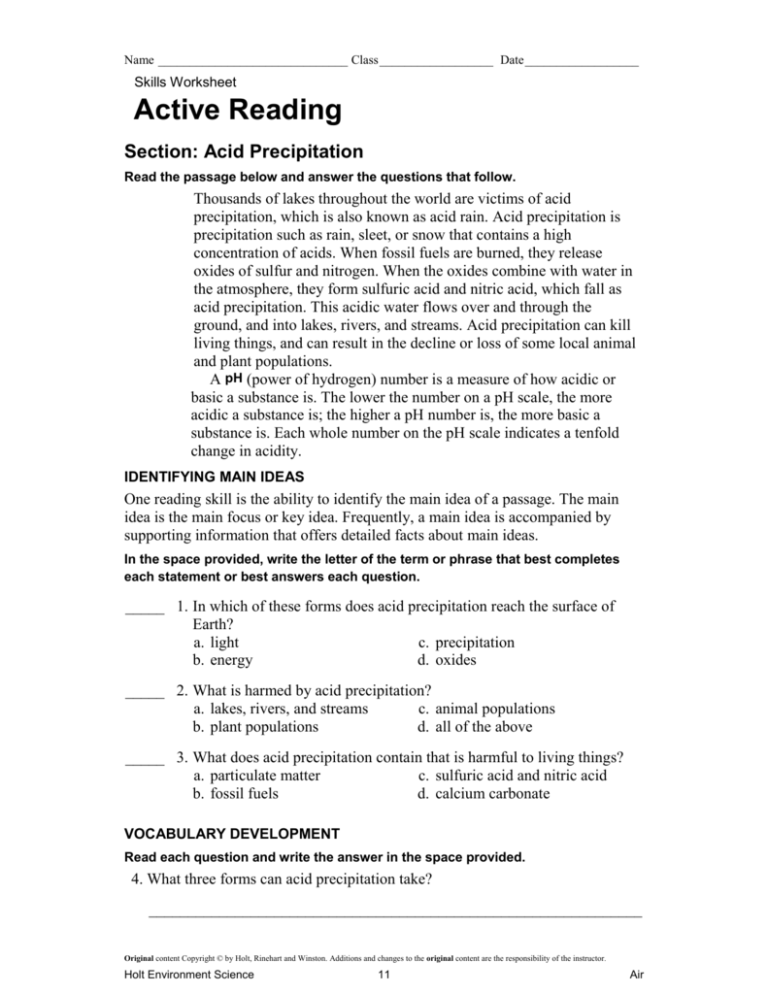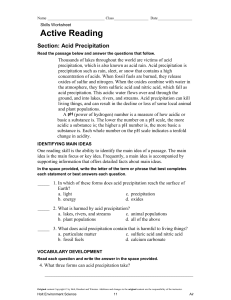Acid Precipitation Worksheet: Active Reading Exercise
advertisement

Name ______________________________ Class __________________ Date __________________ Skills Worksheet Active Reading Section: Acid Precipitation Read the passage below and answer the questions that follow. Thousands of lakes throughout the world are victims of acid precipitation, which is also known as acid rain. Acid precipitation is precipitation such as rain, sleet, or snow that contains a high concentration of acids. When fossil fuels are burned, they release oxides of sulfur and nitrogen. When the oxides combine with water in the atmosphere, they form sulfuric acid and nitric acid, which fall as acid precipitation. This acidic water flows over and through the ground, and into lakes, rivers, and streams. Acid precipitation can kill living things, and can result in the decline or loss of some local animal and plant populations. A pH (power of hydrogen) number is a measure of how acidic or basic a substance is. The lower the number on a pH scale, the more acidic a substance is; the higher a pH number is, the more basic a substance is. Each whole number on the pH scale indicates a tenfold change in acidity. IDENTIFYING MAIN IDEAS One reading skill is the ability to identify the main idea of a passage. The main idea is the main focus or key idea. Frequently, a main idea is accompanied by supporting information that offers detailed facts about main ideas. In the space provided, write the letter of the term or phrase that best completes each statement or best answers each question. _____ 1. In which of these forms does acid precipitation reach the surface of Earth? a. light c. precipitation b. energy d. oxides _____ 2. What is harmed by acid precipitation? a. lakes, rivers, and streams c. animal populations b. plant populations d. all of the above _____ 3. What does acid precipitation contain that is harmful to living things? a. particulate matter c. sulfuric acid and nitric acid b. fossil fuels d. calcium carbonate VOCABULARY DEVELOPMENT Read each question and write the answer in the space provided. 4. What three forms can acid precipitation take? _______________________________________________________________ Original content Copyright © by Holt, Rinehart and Winston. Additions and changes to the original content are the responsibility of the instructor. Holt Environment Science 11 Air Name ______________________________ Class __________________ Date __________________ Active Reading continued 5. When an author puts something in parentheses, he or she is often explaining the word or term that came just before. How does this author use parentheses to explain pH? _______________________________________________________________ _______________________________________________________________ 6. What does a pH number tell you? _______________________________________________________________ SEQUENCING INFORMATION One reading skill is the ability to sequence information, or to logically place items or events in the order in which they occur. Sequence the statements below to trace the path of acid precipitation. Write “1” on the line in front of the first step, “2” on the line in front of the second step, and so on. _____ 7. The oxides combine with water in the atmosphere. _____ 8. Acid precipitation falls. _____ 9. Sulfuric acid and nitric acid are formed. _____ 10. The decline or loss of plant and animal populations can occur. _____ 11. Fossil fuels are burned, releasing sulfur and nitrogen oxides. _____ 12. Acidic water runs over and through the ground, and into lakes, rivers, and streams. RECOGNIZING SIMILARITIES AND DIFFERENCES One reading skill is the ability to recognize similarities and differences between two phrases, ideas, or things. This is sometimes known as comparing and contrasting. Read the question and write the answer in the space provided. 13. What does it mean when something has a high pH level? a low pH level? _______________________________________________________________ RECOGNIZING CAUSE AND EFFECT One reading skill is the ability to recognize cause and effect. Read each question and write the answer in the space provided. 14. What is the basic cause of acid precipitation? What are some effects? _______________________________________________________________ _______________________________________________________________ Original content Copyright © by Holt, Rinehart and Winston. Additions and changes to the original content are the responsibility of the instructor. Holt Environment Science 12 Air ANSWER KEY 18. Accept any reasonable response. Sample answer: The power plants in Country A give off oxides of sulfur and nitrogen that combine with water in the air to make acid precipitation. The wind carries the acid precipita-tion over the border away from Country A, and it falls into Country B, where it acidifies the lake water. The two countries could reach an agreement for Country A to install scrubbers in the power plants, or take other measures to reduce emissions. 19. Accept any reasonable response.Sample answers: Agree. It would be impossible to maintain our society without any pollution. Many businesses would fail, and many people would lose their jobs if businesses were banned from producing any pollution. Even non-industrialized societies produce pollution in the form of smoke from fires. It makes more sense for our society to work toward drastically reducing pollution rather than completely eliminating it. SECTION: AIR, NOISE, AND LIGHT POLLUTION 1. 2. 3. 4. 5. 6. 7. 8. 9. 10. 11 12. 13. 14. c d b a long, thin fibers that are valued for their strength and resistance to heat a potentially fatal disease that arises from exposure to asbestos 2 1 5 3 6 4 Asbestos is a good insulator and fire retardant. Exposure to asbestos can lead to the disease asbestosis, which can be fatal.School officials don’t want to take the chance that a child might inhale asbestos fibers. SECTION: ACID PRECIPITATION Active Reading 1. 2. 3. 4. 5. SECTION: WHAT CAUSES AIR POLLUTION? 1. 2. 3. 4. 5. 6. 7. 8. d d a c a chemical compounds that form toxic fum Harmful; they pollute the air. They burn fossil fuels, which releases huge amounts of sulfur dioxide and nitrogen oxides into the air. 9. oil refineries, chemical manufacturing plants, furniture refinishers, and automobile repair shops 10. two-thirds of all sulfur dioxide and more than one-third of all nitrogen oxides that pollute the air 11. use fewer products that contain VOCs 6. 7. 8. 9. 10. 11. 12. 13. 14. c d c rain, sleet, and snow The author writes “power of hydrogen” in parentheses to explain what the letters in pH stand for. how acidic or basic a substance is 2 4 3 6 1 5 It is more basic; it is more acidic. the burning of fossil fuels; decline or loss of plant and animal populations Map Skills 1. 2. 3. 4. low Barnstable over cities, especially over Boston Answers may vary but should mention that air pollution concentrations are higher over cities. 5. Answers will vary. Original content Copyright © by Holt, Rinehart and Winston. Additions and changes to the original content are the responsibility of the instructor. Holt Environment Science 94 Air









